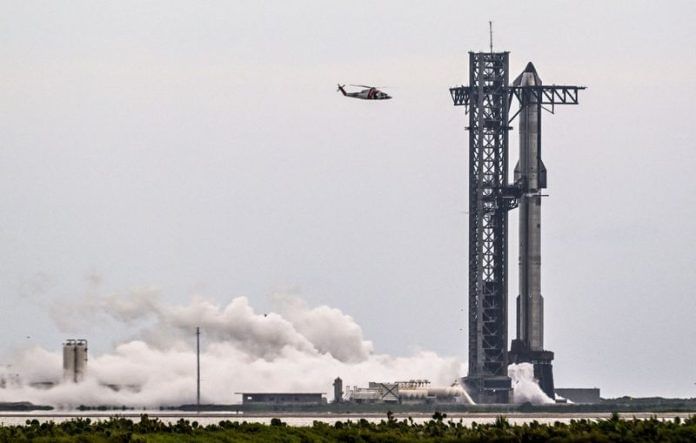By Joey Roulette
WASHINGTON (Reuters) -Elon Musk’s SpaceX postponed the 10th launch of its Starship rocket due to cloudy weather in Texas on Monday, another slight delay in its efforts to overcome development setbacks and achieve several long-sought milestones essential to the Mars rocket system’s reusable design.
The 232-feet (71-metres) tall Super Heavy booster and its 171-feet (52-metres) tall Starship upper half, which together make it taller than New York’s Statue of Liberty, sat on a launch mount at SpaceX’s Starbase rocket facilities ahead of liftoff time that had been moved back a few times because of gloomy weather.
The rocket was filled with millions of pounds of propellant and set to launch when SpaceX around 8:00 p.m. EST (0000 GMT) opted to call off the day’s launch and turn the operation into a launch rehearsal, considering the weather forecast would remain unfavorable throughout the launch window.
SpaceX will try to launch Starship on Tuesday at 7:30 p.m. (2130 GMT)
A liquid oxygen leak at the Starship launchpad had nixed a Sunday launch attempt, billionaire Musk wrote on X overnight, adding SpaceX would try again on Monday. Musk on Monday appeared on SpaceX’s live stream for a brief chat about Starship’s design and its role in ferrying humans to Mars.
Development of SpaceX’s next-generation rocket, key to the company’s powerful launch business and Musk’s goal to send humans to Mars, has faced repeated hiccups this year.
NASA hopes to use the rocket as soon as 2027 for its first crewed moon landing since the Apollo program.
SpaceX’s Starlink satellite internet business, a major source of company revenue, is also tied to Starship’s success. Musk aims to use Starship to launch larger batches of Starlink satellites, which have so far been deployed by SpaceX’s workhorse Falcon 9 rocket, into space.
“In about 6 or 7 years, there will be days where Starship launches more than 24 times in 24 hours,” Musk said on Sunday, replying to a user on X.
This year, two Starship testing failures early in flight, another failure in space on its ninth flight, and a massive test stand explosion in June that sent debris flying into nearby Mexican territory have tested SpaceX’s capital-intensive test-to-failure development approach, in which new iterations of rocket prototypes are flown to their technical limits.
That ethos is markedly different from SpaceX’s rivals such as Jeff Bezos’ Blue Origin, whose New Glenn rocket made an operational debut in January following years of on-the-ground development and testing. The new Vulcan rocket from United Launch Alliance, co-owned by Boeing and Lockheed Martin, had a similar upbringing before its 2024 debut.
With SpaceX’s approach, testing failures early in Starship’s flight prevent the company from gathering vital technical data needed to advance the rocket’s design.
Still, SpaceX, which Musk expects to record around $15.5 billion in revenue this year, has continued to swiftly produce new Starships for test flights at Starbase, a sprawling and rapidly growing rocket industrial complex. The area was made a municipality in May by local voters, many of them SpaceX workers.
Starship’s setbacks underscore the technical complexities of the latest iteration. The ship is packed with far more capabilities than predecessor models such as increased thrust, a potentially more resilient heat shield and stronger steering flaps crucial to nailing its atmospheric reentry – key traits of its rapidly reusable design that Musk has long pushed for.
SpaceX has a lengthy to-do list for Starship’s development before the rocket begins routine missions envisioned by Musk. That includes demonstrating safe returns from space, payload deployments in orbit and complex in-space propellant refueling which is crucial to its moon mission assignments for NASA.
Whenever Starship can launch, the rocket system will liftoff from Texas and separate in half dozens of miles in altitude, with its Super Heavy booster returning for a water landing off the Texas coast, while Starship ignites its own engines to blast further into space.
In space, Starship will attempt to deploy mock Starlink satellites and reignite an engine along its suborbital path around the globe. Atmospheric reentry over the Indian Ocean will test its exterior steering flaps and an array of experimental heat shield tiles as the ship blazes through intense friction and heat.
(Reporting by Joey Roulette in Washington; Editing by Nia Williams and Michael Perry)
Disclaimer: This report is auto generated from the Reuters news service. ThePrint holds no responsibility for its content.




